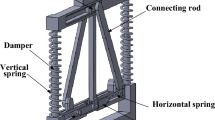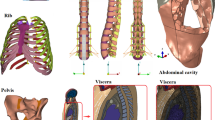Abstract
In petroleum drilling engineering, drilling shakers are critical devices for cleansing solid particles and recycling drilling fluid. For the problem that the vibration screen with a single frequency usually results in flurry overflow due to the blocking of screen mesh, a selfsynchronous vibratory system with dual-frequency and dual-motor excitation is proposed. But it is not clear about the synchronization mechanism and dynamic characteristics of the system, which causes a lack of theoretical description for the source of synchronization phenomenon. Hence, this paper explores the synchronization mechanism and dynamic characteristics around the proposed system above. First, vibration and stability theory are employed to master the dynamic characteristics of the system, and the dynamic model is established by Lagrange equation. Then, displacement responses of the system are obtained by dimensionless formulas. Synchronous condition and synchronous stability between the unbalanced rotors are derived with small parameter method and Poincare method. Finally, some computer simulations are implemented to further verify the correctness of the theoretical analysis. The research result shows that the synchronous ability between the two unbalanced rotors actuated by dual-frequency excitation is related to the distance from the rotating center of the motor to the centroid of supporting body, and the greater the distance value, the better the synchronization of the vibrating system. This study will promote the recycle technology development of drilling fluid and settlement of the common scientific issues in vibrating synchronization.
Similar content being viewed by others
References
I. I. Blekhman, Synchronization in Science and Technology, ASME Press, New York, USA (1988).
I. I. Blekhman, Selected Topics in Vibrational Mechanics, World Scientific, Singapore (2004).
B. C. Wen, J. Fan and C. Y. Zhao, Synchronization and Controlled Synchronization in Engineering, Science Press, Beijing, China (2009).
L. Sperling, B. Ryzhik and C. Linz, Simulation of two-plane automatic balancing of a rigid rotor, Mathematics and Computers in Simulation, 58 (4) (2002) 351–365.
J. M. Balthazar and J. L. P. Felix, Short comments on selfsynchronization of two non-ideal sources supported by a flexible portal frame structure, J. of Vibration and Control, 10 (12) (2004) 1739–1748.
J. M. Balthazar and J. L. P. Felix, Some comments on the numerical simulation of self-synchronization of four nonideal exciters, Applied Mathematics and Computation, 164 (2) (2005) 615–625.
Y. J. Hou and G. X. Yan, Electromechanical-coupling mechanism of self-synchronous vibrating system with threemotor-driving, J. of Vibration Engineering, 19 (3) (2006) 354–358 (in Chinese).
Y. J. Hou et al., Synchronization investigation of vibration system of two co-rotating rotor with energy balance method, Advances in Mechanical Engineering, 8 (1) (2016) 1687814015626023.
P. Fang, Y. J. Hou, Y. H. Nan and L. Yu, Study of synchronization for a rotor-pendulum system with Poincare method, J. of Vibration Engineering, 17 (5) (2015) 2681–2695.
C. Y. Zhao, Y. M. Zhang and X. L. Zhang, Synchronization and general dynamic symmetry of a vibrating system with two exciters rotating in opposite directions, Chin. Phys. B, 19 (3) (2010) 030301.
X. L. Zhang, B. C. Wen and C. Y. Zhao, Synchronization of three non-identical coupled exciters with the same rotating directions in a far-resonant vibrating system, J. of Sound and Vibration, 332 (9) (2013) 2300–2317.
X. L. Zhang, B. C. Wen and C. Y. Zhao, Vibratory synchronization transmission of a cylindrical roller in a vibrating mechanical system excited by two exciters, Mechanical Systems and Signal Processing, 96 (2017) 88–103
X. X. Kong, X. L. Zhang and X. Z. Chen, Synchronization analysis and control of three eccentric rotors in a vibrating system using adaptive sliding mode control algorithm, Mechanical Systems and Signal Processing, 72–73 (2016) 432–450
A. Djanan., B. Nbendjo and P. Woafo, Effect of selfsynchronization of DC motors on the amplitude of vibration of a rectangular plate, European Physical Journal Special Topics, 223 (4) (2014) 813–825.
P. Fang, Y. J. Hou, Y. H. Nan and L. Yu, Study of synchronization for a rotor-pendulum system with Poincare method, J. of Vibroengineering, 17 (5) (2015) 2681–2695.
P. Fang and Y. J. Hou, Synchronization characteristics of a rotor-pendula system in multiple coupling resonant systems, Proceedings of the Institution of Mechanical Engineers, Part C: J. of Mechanical Engineering Science, 232 (10) (2018) 1802–1822.
Y. S. Yao, H. N. Song and Z. X. Feng, Experiment on double-frequency composed vibrating screen, China J. of Highway and Transport, 21 (4) (2008) 122–126 (in Chinese).
Z. X. Feng, C. R. Meng and H. N. Song, Screening theory with double-frequency vibration, J. of Chang’an University (Natural Science Edition), 30 (2) (2010) 101–105 (in Chinese).
J. Chen, Mathematical Model and Speed Adjustment System of Alternating Motors, Defense Press, Beijing (1989) (in Chinese).
Author information
Authors and Affiliations
Corresponding author
Additional information
Recommended by Associate Editor Junhong Park
Min Zou received the B.E. from Sichuan University Jinjiang College, China, in 2016. He is currently pursuing the M.E. at Southwest Petroleum University, China. His research interests include dynamics of mechanical systems and nonlinear systems, and dynamics of synchronization systems.
Pan Fang completed his Ph.D. in Mechanical Engineering from Southwest Petroleum University, China, in 2016. Presently he is a Master Tutor at Southwest Petroleum University, China. His research interests include dynamics of multi-body systems and vibration control.
Rights and permissions
About this article
Cite this article
Zou, M., Fang, P., Peng, H. et al. Study on synchronization characteristics for self-synchronous vibration system with dual-frequency and dual-motor excitation. J Mech Sci Technol 33, 1065–1078 (2019). https://doi.org/10.1007/s12206-019-0206-4
Received:
Revised:
Accepted:
Published:
Issue Date:
DOI: https://doi.org/10.1007/s12206-019-0206-4




